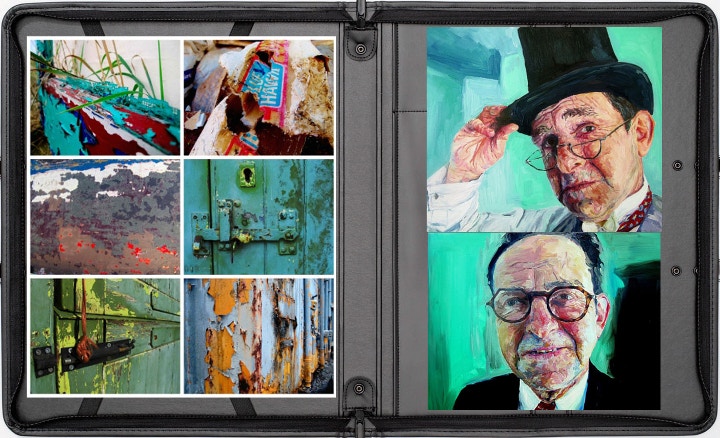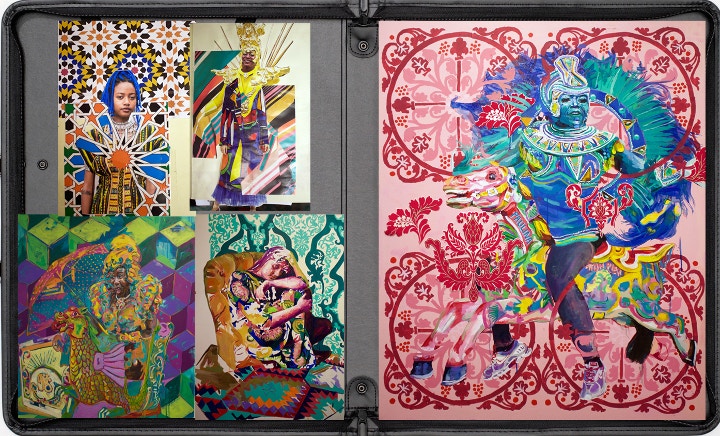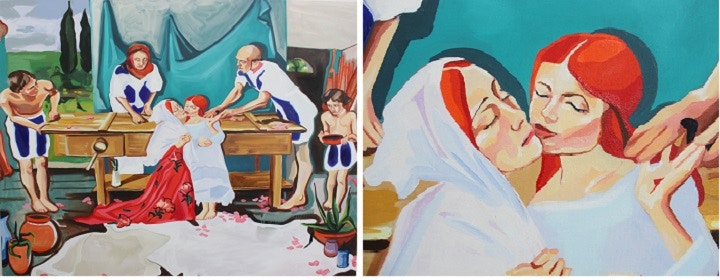Discover Our Guide to Building a Portfolio
Posted by Cass Art Staff on 20th Aug 2021
Portfolio Season is upon us, with students across the country compiling and fine-tuning their cherished art work. We want to make this time as stress-free as possible, so we’ve asked our former Student Ambassadors Felicity Meachem and Anna Kenneally to give their top tips on creating the perfect portfolio.
Hi Felicity and Anna! What advice would you give students who are in the process of preparing their portfolios and applying to an art course?
Felicity: Portfolios are going to be an important tool in your artistic career, not just for applying to university, so this is great practice! It's a bit of a cliché but definitely don’t leave it to the last minute. Portfolios take time and should be constantly updated as you make new work. Make sure to pay close attention to detail - it shows you are professional and are proud of your work. Applying for university is not just about grades anymore, your work is what’s key. Most importantly, do not let someone else dictate your portfolio for you. Always welcome a fresh set of eyes to look at your work but remember, you are the artist and you are in charge. University is about you becoming an independent artist rather than always relying on what your teachers tell you to do. Trust your instincts, you can’t pretend to be something you're not!
Anna: Get other people’s opinions when selecting work to include as they may notice things you have overlooked. Limit the amount of work in a submission; really good examples of work can become lost in a large portfolio. This portfolio is a chance to not only show off your work, but showcase creative achievements. These can include images of exhibitions you have been a part of, interviews, dissertations or personal projects.

Extract from Felicity Meachem's Portfolio
How important is it to show your own style in your portfolio?
Felicity: Depending on what kind of course you're applying for, it can vary. In terms of painting it is very important. Showing your own unique flair is what interviewers are looking for. They see the same thing all the time so try to find some kind of distinctive hook or thumbprint that sets you apart from other candidates. For instance, you could use something unconventional to fold your work in. I knew a girl who put her work in an old vintage suitcase that she inherited from her grandparents.
Anna: The main thing the selectors will be looking for is a coherent body of work; they want to see a clear insight into the applicant’s interests and gain an understanding of their practice. It is good to not only show your best work, but also work that links together in terms of idea or project. Playing to your strengths will work in your favour. If you feel strong in a certain medium, make sure this is being communicated.

Extract from Anna Kenneally's Portfolio
What are your five must-have portfolio products?
Felicity: I would recommend Cass Art's Presentation Portfolio. It's waterproof, and you're going to want something lightweight especially if you are travelling far for an interview. In 2014 I took a cumbersome leather portfolio without a shoulder strap to a London interview and ended up doing my back in and cutting into my shoulder- big mistake! So make sure you get one with a good grip on the handle. I would also advise you to get your hands on some Cass Art Presentation sleeves to protect your work. I would get various sizes just in case. Plastic sleeves are a bit controversial - some say the glare from light distracts from your work - but I actually love them! They make life so much easier, especially when organising and placing your work. If you're not a sleeve fan, I would suggest getting some good quality card - something that can easily be moved around. What I wish I had during my interviews was a Jakar Teletube container with strap. This can hold larger work- which universities love to see- and you can roll artwork up and keep it safe. Finally, I recommend the Seawhite Euro Portrait Sketchbook. This set comes in various sizes, so you can show you can work on different scales.
Anna: A decent camera to take good quality photos of your work is essential. Cameras can often be loaned from university or college, so you don't need to fork out the cash for a new one. To position your artwork onto surfaces (before taking photos) I recommend 3M Spray Mount 400ml.

Extract from Felicity Meachem's Portfolio
How far in advance should you start preparing your portfolio?
Felicity: I would say a minimum of one month. You don’t want to start too early - you’ll change your mind a lot as you will always be making new work. You also don’t want to leave it to the night before your interview - though no doubt there will be last minute tweaks!
Anna: Giving yourself as much time as possible is best, allowing you to consider choices of work and think about order and layout of the page. Photographing work and recording medium and dimensions on completion will help build a portfolio without a last minute panic. Showing both older and more recent work can help give an insight into your progression and interests.
Are there any things that you think are vital to include in a portfolio?
Felicity: Though it is starting to become quite old fashioned and traditional, I believe Its vital to have life drawing in your portfolio. Drawing from life is an easy way of showing you have good eye for proportions and recreating life into a new picture space. Sketchbooks should be mandatory! They are where all the initial ideas happen, so they give the interviewer a way of seeing into your thought process and progression to your final products. It is also important to include artist research and other visual inspiration such as photography. I think what my interviewers especially liked was that I brought a big painting to show at my interview - they said that it’s not often they get to see big paintings in the flesh. So if you can bring maybe one larger piece of work along with you, do!
Anna: Sketchbooks and preliminary work are perfect when presenting a portfolio, but only if they are important to you within your practice. If your portfolio is being looked through at an interview, it can be useful to add little bookmarks to sketchbook or portfolio pages that you would especially like to talk about.
Do you think that it’s still important to send physical portfolios? Do you think we will be submitting portfolios digitally in the future?
Felicity: It is definitely still important to send physical portfolios. At the end of the day, art is made to be viewed physically in front of you. A lot of art is 3D and can only be fully appreciated in the flesh, such as sculpture, impasto painting, textiles and fashion. Though there are digital forms of art such as graphics and illustration, these still turn into physical products. We are actually currently submitting Digital portfolios and I think we probably will be doing more so in the future. It is good practice to photograph your work. These are also quite challenging as you are often only allowed a few selected images to submit.

Extract from Anna Kenneally's portfolio
Anna: I think it is important to send physical portfolios, as it can be difficult to get a good idea of scale, surface, and colour from photographs. In recent years courses have begun to ask for digital submissions. If successful, many ask to see physical examples of work. Digital submissions can allow you to make really good documentations of your work, which will also be useful for other submissions and artist websites. Adjusting contrast and cropping images when putting together an online portfolio is very important, as a bad photograph can reflect poorly on the applicant. Another advantage of submitting a digital portfolio is that you can add images showing close up details of a favourite piece.
Feeling Inspired?
See more of Anna Kenneally's artwork
See more of Felicity Meachem's artwork
Check out our blog on Top Tips to Personalise Your Portfolio



